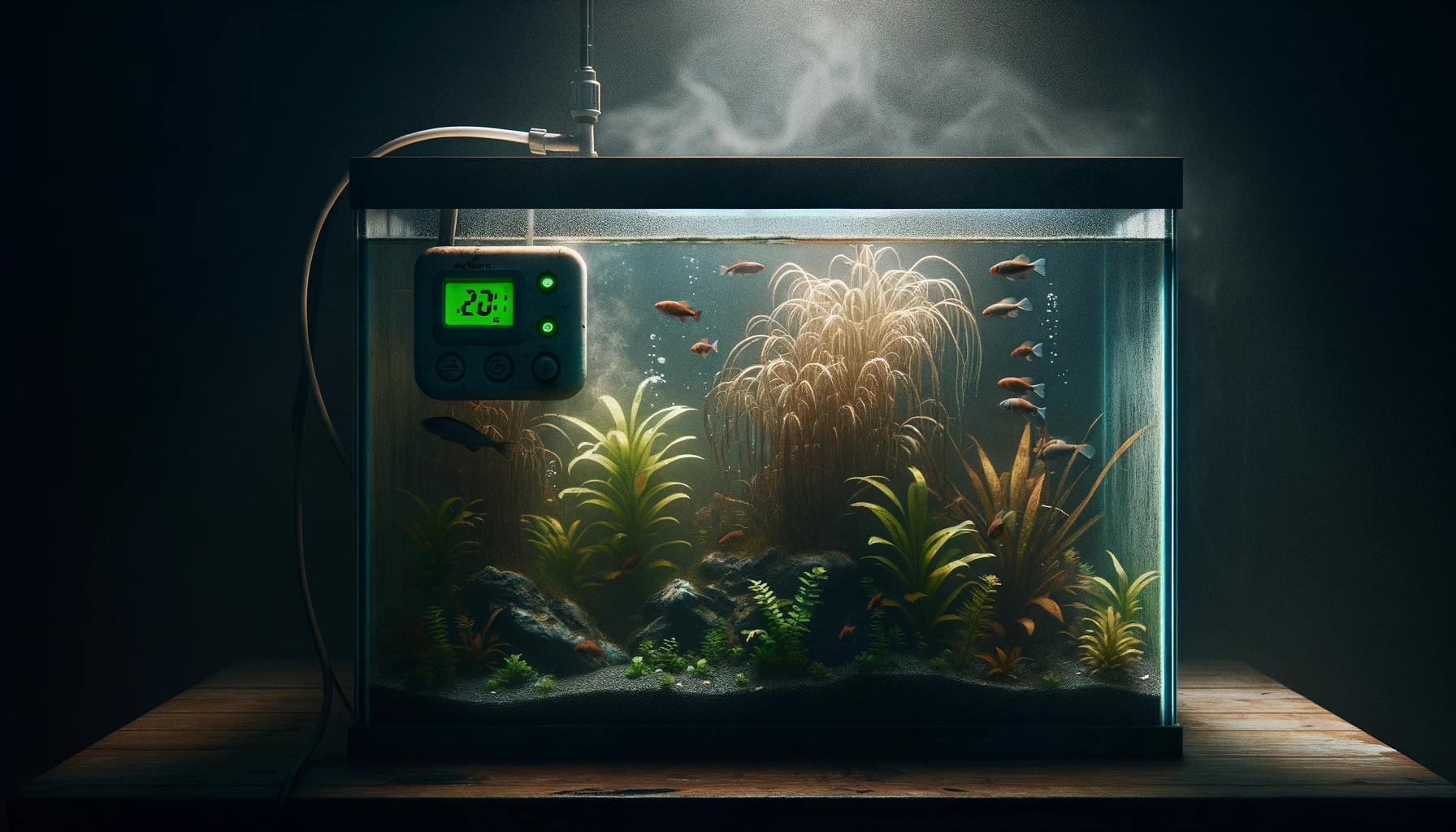As aquatic enthusiasts, it is our responsibility to create a thriving ecosystem within our aquariums, ensuring the health and well-being of its inhabitants. One crucial aspect contributing to the success of a planted aquarium is maintaining optimal levels of carbon dioxide (CO2) for plant growth.
As an established aquarium expert with up-to-date knowledge and expertise, this article will explore the insights and recent findings related to low CO2 levels in planted aquariums.
Understanding the importance of carbon dioxide in planted tanks is paramount. Besides serving as an essential component during photosynthesis, CO2 is an energy source for plants by aiding nutrient absorption and metabolic function. Insufficient levels of CO2 can lead to stunted growth, weakened vegetation, and algae overgrowth issues, often resulting in reduced aesthetics and potential detriment to fish health.
Key Takeaways
- Slow or stunted plant growth indicates low CO2 levels.
- Yellowish leaves are a common sign of CO2 deficiency.
- Increased algae growth and imbalance are signs of low CO2 levels.
- Regularly conduct water tests to monitor CO2 levels.
Understanding CO2 in Planted Aquariums

For many new aquarium hobbyists, CO2 is not a something to be considered for their fish tanks.
To put it simply, CO2 is a critical ingredient for photosynthesis, the process where plants convert light into energy.
Without sufficient CO2, your aquatic plants may struggle to grow, showing signs of distress and potentially affecting the overall health of your aquarium.
What is CO2 and its role in a planted aquarium
Carbon dioxide, commonly known as CO2, plays a vital role in photosynthesis, fueling plants by converting light into chemical energy. Maintaining an appropriate level of CO2 in a planted aquarium is essential for the overall health and thriving growth of your aquatic vegetation.
Insufficient levels of CO2 can result in visible indications of deficiency, such as stunted or discolored leaves, hampering the development of your plants. Therefore, monitoring and ensuring adequate CO2 concentration is critical to fostering optimal plant growth.
However, striking a delicate balance is essential when adding CO2 to your aquarium. Excessive amounts of this gas can be harmful to your fish inhabitants. Thus, regularly assessing and adjusting the CO2 levels is necessary to promote plant vitality and aquatic life well-being within your tank.
Importance of CO2 for Plant Growth
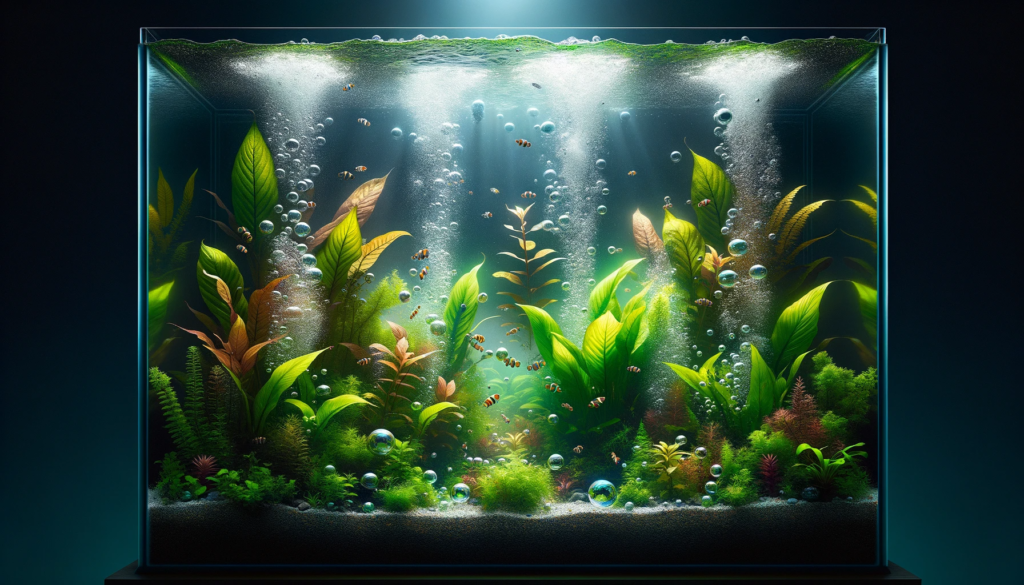
You might wonder why CO2 is so critical for the healthy growth of your aquarium plants.
Essentially, plants require CO2 for photosynthesis, a process that allows them to convert light into the energy they need to grow.
Without sufficient CO2, your plants can’t perform this critical function efficiently, leading to slower growth and potential damage.
How CO2 affects plant growth in aquariums
In managing your planted aquarium, it’s essential to understand how CO2 affects plant growth. Low CO2 levels can lead to stunted growth, leaf discoloration, and algal blooms, all signs of CO2 deficiency. Aquatic plants need adequate CO2 for photosynthesis, the process through which they convert light into energy.
|
Effects of CO2 | Result in Planted Aquarium ————————-|———————————– Adequate CO2 | Optimal plant growth Low CO2 | Stunted growth, leaf discoloration CO2 Deficiency | Algal blooms Balanced CO2 | Healthy aquatic ecosystemWithout enough CO2 in planted aquariums, plants can’t produce the nutrients they need, leading to poor health. Therefore, monitoring and adjusting CO2 levels are key to maintaining a thriving environment for your aquarium plants.
Why plants need CO2 in planted tanks
Understanding the importance of CO2 for plant growth in your planted tanks can greatly improve the health and vitality of your aquatic plants. Plants need CO2 as it’s vital for photosynthesis, a process that fuels plant growth. When CO2 levels are low, signs of a CO2 deficiency like slow growth and dull coloration may appear.
1. CO2 Injection: Consider a CO2 injection system to maintain optimal CO2 concentration. This can alleviate low CO2 levels and promote lush plant growth.
2. Monitoring: Regularly monitor your tank for signs of low CO2 to prevent plant health issues.
3. Balance: Achieve a balance between oxygen and CO2. Too much CO2 can harm aquatic life.
Methods to Add CO2 in your Planted Aquarium
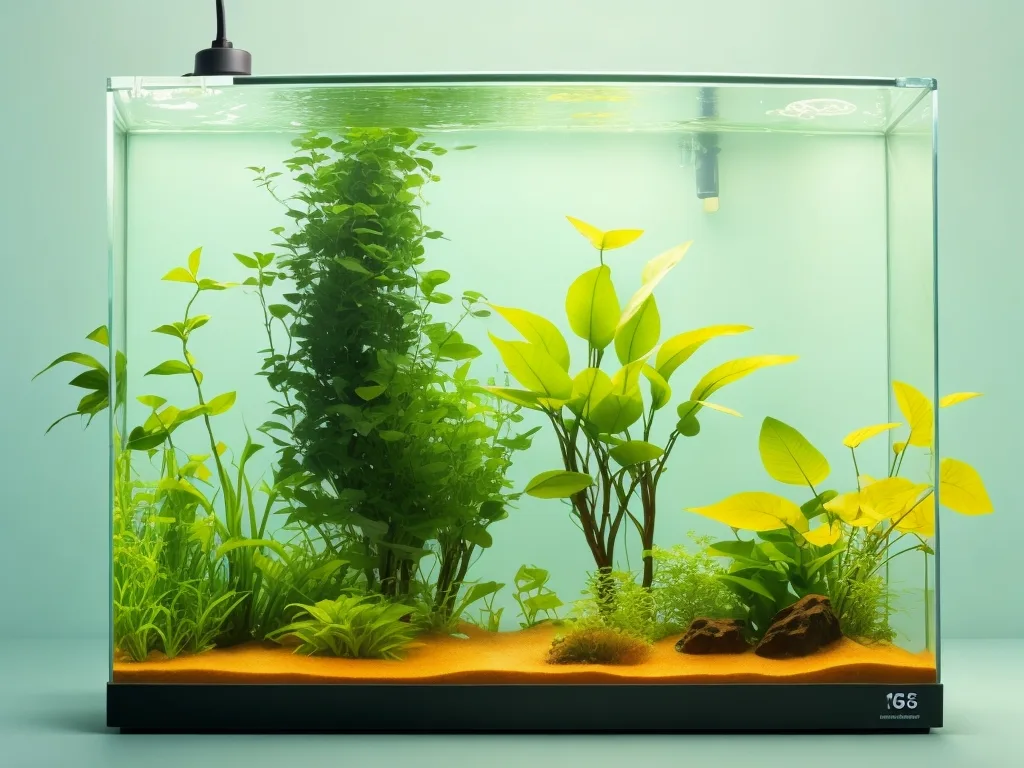
You’ve identified low CO2 levels in your planted aquarium, but what’s the next step?
Consider exploring methods like pressurized CO2 injection, a popular and effective way to boost levels.
However, don’t overlook alternative CO2 supplementation options, as they can offer unique benefits tailored to your specific setup.
Adding CO2 to your fish tank is vital.
Pressurized CO2 injection
One effective method to maintain adequate CO2 levels in your planted tank is through a pressurized CO2 injection system. This system uses a CO2 regulator to precisely control the amount of CO2 injected into the aquarium. This is essential because plants need a particular CO2 level to thrive.
Here’s why this method is foolproof:
1. Pressurized CO2 systems offer a steady and controlled release of CO2.
2. Regular CO2 tests can be run, allowing you to identify signs of low CO2 early.
3. CO2 injection systems are easy to install and use.
However, it’s crucial to monitor the pressurized CO2 injection process to ensure that the CO2 level doesn’t spike or drop suddenly, which can harm your plants and fish. Regular testing and adjustments can help maintain a healthy environment in your planted aquarium.
Alternative CO2 supplementation options
While a pressurized CO2 injection system is an effective solution, there are alternative methods you can use to supplement CO2 in your planted aquarium.
DIY yeast-based systems are one way of injecting CO2. These systems work by mixing yeast and sugar to produce CO2.
Another alternative CO2 supplementation involves using a CO2 tablet. However, maintaining the amount of CO in planted tanks using these methods can be challenging.
If you notice signs of low CO2, such as slow plant growth or discoloration, it could indicate CO deficiency. In this case, adjusting the CO2 regulator on the pressurized CO2 system or increasing the frequency of CO injection may be needed.
Always monitor the CO2 levels closely to prevent any harm to your aquatic plants.
Signs of Low CO2 Levels in your Planted Aquarium
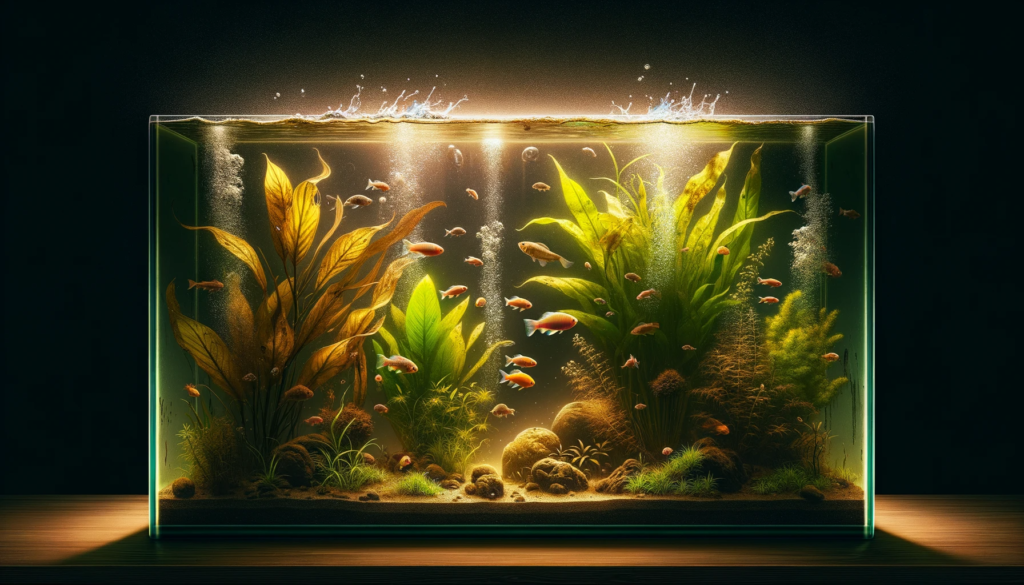
Recognizing the signs of low CO2 levels in your planted aquarium is crucial to maintain a healthy environment for your aquatic plants.
You might notice the growth of your plants becoming slow or stunted, and an imbalance of algae growth.
It’s especially important to frequently check and adjust CO2 levels to ensure an optimal tank environment.
Slow or stunted plant growth
If your aquarium plants’ growth is slow or stunted, it’s likely a sign of low CO2 levels in your tank. CO2 plays a crucial role in the process of photosynthesis, enabling plants to grow by turning light into energy. When CO2 is deficient, the growth of aquatic plants suffers.
Yellowish Leaves: Low CO2 often results in yellowish leaves, as chlorophyll production slows down.
Stunted Growth: Your planted aquarium might show stunted growth. This is because plants need CO2 to grow, and without it, they struggle.
Slow Growth: The rate at which your aquarium plants grow might significantly decrease.
Algae growth and imbalance
You’ll notice an increase in algae growth and imbalance in your planted aquarium when CO2 levels are too low. This is because low CO2 levels limit the photosynthesis process of your aquatic flora, leading to poor plant density. As the plants struggle, algae seize the opportunity to flourish, disrupting your aquatic ecosystem.
So, it’s essential to keep a watchful eye on your aquarium water. Regularly conduct water tests to monitor the CO2 levels. If you detect low CO2, take immediate steps to rectify the imbalance. By maintaining appropriate CO2 levels, you not only curb unwanted algae growth but also ensure the healthy growth of your aquatic flora.
Frequently checking and adjusting CO2 levels
Picking up on the signs of low CO2 levels in your planted aquarium isn’t just crucial for keeping algae in check, it’s also key to promoting healthy plant growth. You must be vigilant in frequently checking and adjusting CO2 levels.
Invest in a high-quality CO2 regulator. It’s a reliable tool for maintaining CO2 balance, ensuring a thriving environment in your planted tank.
Regularly perform a CO2 test. This lets you monitor CO2 concentration, helping you adjust levels in the aquarium when necessary.
Don’t hesitate to add CO2, if needed. This can counter low CO2 signs and boost plant health.
How to Maintain Proper CO2 Levels in a Planted Aquarium
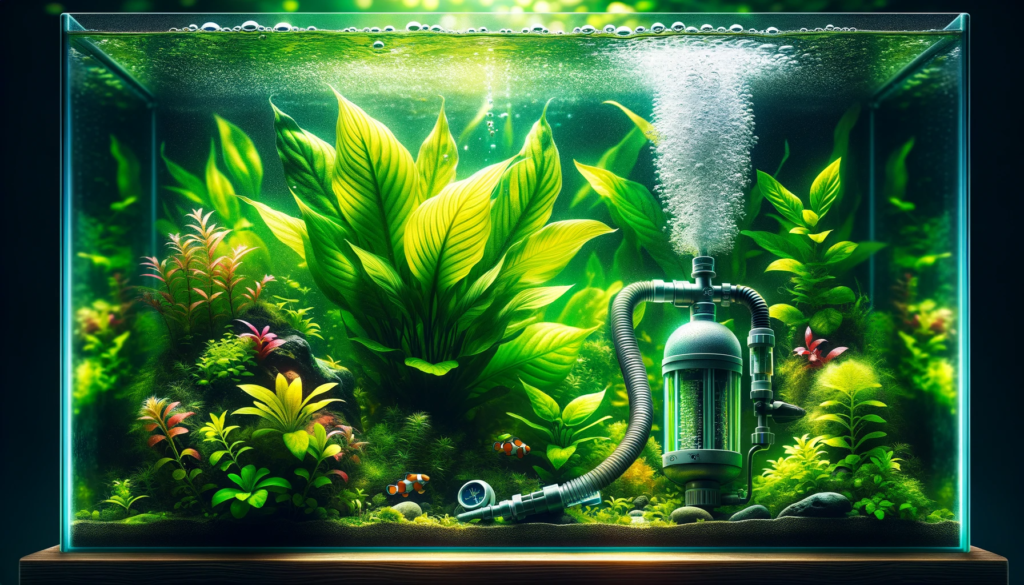
Maintaining the right CO2 levels in your aquarium isn’t just a guessing game. You’ll need to use a drop checker to accurately monitor these levels and optimize water flow to ensure proper CO2 distribution.
Using a drop checker to monitor CO2 levels
To monitor CO2 levels in your planted aquarium effectively, it’s recommended to use a drop checker. This tool helps detect signs of low CO2 levels and maintains a healthy environment for your aquatic plants.
Placement:
Position your drop checker halfway in the water column, ensuring the opening is below the water surface.
Reading:
A green color indicates optimal CO2 levels, blue signifies low CO2, while yellow warns of excessive carbon dioxide.
Adjustment:
Based on the drop checker color, you can either increase or decrease CO2 supply, ensuring a balanced proportion of carbon dioxide in your aquarium.
Optimizing water flow for CO2 distribution
You’ll need to optimize your aquarium’s water flow to ensure proper CO2 distribution, as this is one of the key steps in maintaining ideal CO2 levels in your planted tank.
Low CO2 levels can inhibit the growth of your plants, as CO2 is a vital source of carbon.
Optimizing water flow helps distribute CO2 effectively. Most CO2 systems dissolve the gas into the tank water, but without sufficient water flow, areas of your aquarium may lack CO2.
Use water pumps or powerheads to enhance flow and ensure CO2 distribution.
Monitor areas with slow-growing or unhealthy plants for signs of low CO2 levels.
Finding the ideal CO2 balance for your aquarium
After optimizing water flow for CO2 distribution, it’s time to focus on finding the ideal CO2 balance for your aquarium. Low CO2 levels can lead to signs of low CO2, such as stunted plant life, excessive algae, and compromised fish health.
To maintain an ideal balance:
1. Use a CO2 diffuser to ensure high light plants get sufficient carbon dioxide.
2. Monitor CO2 levels regularly, striving for about 30 ppm.
3. Adjust CO2 input as needed based on plant growth and fish behavior.
Also Read: Water Chemistry of Aquariums
The Impact of Low CO2 Levels on Fish Health
While you may be focused on the health of your plants in your aquarium, it’s important to remember the impact of CO2 levels on your fish as well.
Low CO2 levels can have adverse effects on fish and other aquatic animals, leading to health issues that can be difficult to rectify.
Therefore, understanding how to prevent CO2-related health issues in fish is crucial for maintaining a balanced and thriving aquatic environment.
Effects of low CO2 on fish and other aquatic animals
Maintaining optimal CO2 levels in your planted aquarium is essential for the health and well-being of your fish and other aquatic animals. Here are some key reasons why low CO2 levels can have detrimental effects:
- Impaired respiration: Fish and other aquatic animals rely on CO2 for proper respiration. Insufficient levels of CO2 can hinder their ability to breathe effectively, leading to respiratory distress and hampering their overall health and growth.
- Declining fish population: Inadequate CO2 levels can disrupt the reproductive processes of fish, resulting in a decline in their population over time. A lack of sufficient carbon dioxide can negatively impact breeding behaviors and reduce successful reproduction, ultimately affecting the number of fish within the aquarium.
- Ecosystem imbalance: Low levels of CO2 significantly disturb the delicate balance within an aquarium ecosystem. The absence or scarcity of carbon dioxide disrupts crucial biochemical reactions that support various life forms, such as bacteria, plants, algae, and microorganisms. This disruption has a cascading effect on all aspects of aquatic life present in the tank.
These effects highlight how low levels of CO2 contribute to an unhealthy environment for your beloved aquatic companions.
To ensure a thriving aquarium environment, it is vital to carefully monitor and manage appropriate CO2 levels within your tank setup. Remember that maintaining proper carbon dioxide concentrations is paramount for promoting the well-being and longevity of your aquatic friends
Preventing CO2-related health issues in fish
So, how can you prevent CO2-related health issues in your fish? The first step is to monitor CO2 levels in your planted aquarium regularly. Watch for signs of low CO2 that may indicate potential health issues in fish.
Here’s a simple guide:
| Action | Purpose | Frequency |
|---|---|---|
| Monitor CO2 levels | Prevent low CO2 | Daily |
| Check for signs of low CO2 |
Early detection of issues | Weekly |
| Regular water change | Maintain balance in CO2 levels | Weekly |
Use CO2 indicators and test kits to keep an eye on the CO2 levels. If the levels drop too low, adjust using a CO2 regulator. Regular water changes also help maintain a balance in CO2. Keep in mind, preventing CO2-related health issues is crucial for a thriving aquarium and the health of your fish.
So, you’re not just an aquarium enthusiast, you’re a botanical superhero, battling against the invisible foe of low CO2 levels.
With your newfound knowledge, you can breathe life back into your underwater jungle.
Remember, maintaining the right CO2 balance isn’t just science, it’s an art.
It’s the difference between a lifeless tank and an aquatic paradise.
So, don your cape, adjust your CO2 levels, and watch as your aquarium transforms into a thriving underwater Eden.
Q: What are the signs of low CO2 levels in a planted aquarium?
A: Signs of low CO2 levels in a planted aquarium can include slow or stunted plant growth, yellowing or pale leaves, algae overgrowth, and weak or unhealthy plants.
Q: What is a planted tank?
A: A planted tank is an aquarium that contains live aquatic plants, which provide natural filtration, oxygenation, and a visually pleasing environment for fish and other aquatic creatures.
Q: What is carbon dioxide (CO2) and why do plants need it?
A: Carbon dioxide is a gas that is essential for photosynthesis in plants. During photosynthesis, plants use CO2, along with water and sunlight, to produce glucose and oxygen, which they need for energy and growth.
Q: What is a drop checker and how does it help monitor CO2 levels?
A: A drop checker is a device used by aquarists to measure the concentration of CO2 in a planted aquarium. It typically contains a pH indicator solution that changes color based on the CO2 levels in the water.
Q: How can low-tech tanks be maintained without pressurized CO2?
A: Low-tech tanks can be maintained without pressurized CO2 by using aquarium-safe liquid or tablet carbon supplements, optimizing lighting, controlling nutrient levels, and providing sufficient water flow and surface agitation.
Q: How does low CO2 affect algae growth in a planted aquarium?
A: Low CO2 levels can lead to an imbalance in the aquarium ecosystem, favoring the growth of algae over aquatic plants. Algae can thrive in conditions where plants are unable to compete effectively due to limited CO2 availability.
Q: How does surface agitation affect CO2 levels in a low-tech tank?
A: Surface agitation, such as using air stones or a water pump, can increase the exchange of gases between the aquarium water and the surrounding air. This can result in the loss of dissolved CO2, potentially leading to lower CO2 levels in the tank.
Q: How do pH and KH levels affect the availability of CO2 for plants?
A: The pH and KH levels in the aquarium water determine how much CO2 is available for plants. Carbonate hardness (KH) helps stabilize pH, and a higher KH concentration can make it more challenging for plants to absorb CO2 effectively.
Q: Are there specific plants that require extra CO2 in a planted aquarium?
A: Yes, there are certain plants that are considered high-demand or CO2-dependent plants. These plants typically have higher growth rates and require more CO2 to support their rapid growth and development.
Q: Why is it important to provide enough light for plants in a planted aquarium?
A: Light is one of the essential factors for photosynthesis in plants. Providing sufficient light ensures that plants can capture and convert energy effectively, promoting their growth and overall health in the aquarium
.

